Mereweather loved Venice, its cultural heritage, its beauty. Semele of Greek mythology is turned into
an orphan daughter of noble Anglo-French lineage. She explores
the city and the lagoon giving the reader something of a
guided tour. After her wish to see the Spirit of all Beauty is
granted, she goes mad; she dies a few months later. The book,
which impressed an Italian reviewer, became something of a
guide to Mereweather's own inner struggle "loving Beauty and
Art, Spirit and Embodiment, with a frenzied enthusiasm,
excluding all rational consideration of human duties and
every-day life" (Semele, p. x).
One source of inspiration is the Swedish
mystic Emanuel Swedenborg. In his Memorable Relations
Semele "read how a too sensitive, or rather diseased,
imagination carried the writer into the realms of spirits; and
how at pleasure he could invade the Blissful Land".
(Semele, p. 17)
The set-up can be boring: the Spirit is
the poetical cicerone of Semele who, in turn, is guiding the
reader. Nevertheless, the book is full of cultural, historical
and linguistic details, including an interesting description
of the tableland of the Sette Comuni in the province of
Vicenza. Click on the Sette Comuni link
above.
See below for some extracts.
Various illustrations have been added.
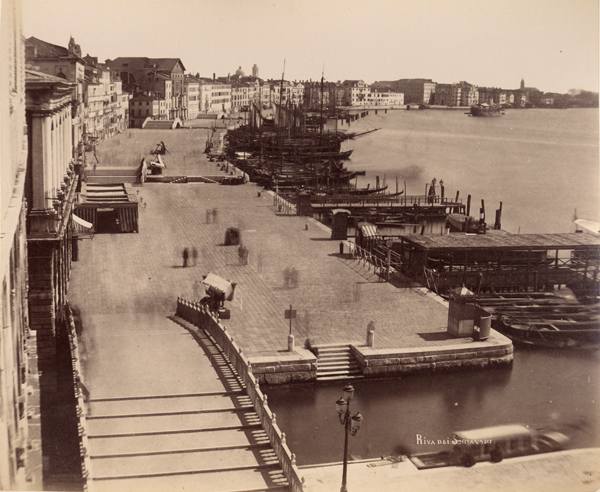
Riva degli Schiavoni,
from Ponte della Paglia
Photograph, probably by
Paolo Salviati, c. 1870
"When Semele first arrived at Venice, she took up her
residence at a large hotel on the Riva degli Schiavoni, once
belonging to the family Bernardo, built in the Pointed style
of architecture at the beginning of the fifteenth century.
Under her windows ran a spacious quay, crowded with people
clad in a variety of costumes, and speaking a diversity of
tongues." (Semele, p. 35)
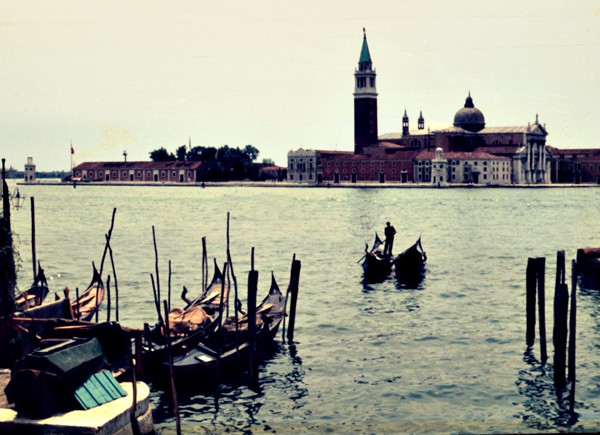
San Giorgio Maggiore
Photograph by
Christer Björkvall, c. 1955
"Before her, as she stood on the balcony, lay the
island of St. Giorgio Maggiore, once, in very old times,
crowned with cypresses, and refreshing the eye with its
verdure; now groaning under the weight of a Renaissance
church, barracks, and artillery." (Semele, p. 35)
Inspecting Venice
In a gondola Semele
"floated
along off the Riva degli Schiavoni, rendezvous of innumerable
‘trabaccoli’, two-masted coasting vessels, from the Dalmatian
and Istrian ports. She then passed the south entrance to the
arsenal, the ‘Arzanà de' Viniziani’ of Dante, rounded the
Giardino Publico, rowed under the interminable wall which
bounds the north side of the arsenal, and pursued her course
along the Fondamenta Nuove, having on the right the Cemetery
and Murano, that once renowned island, peopled, in times long
passed, by fugitives from Hunnic and Lombard ravagers, and
later, birthplace or favourite haunt of many learned
spirits,—island, whose glass manufacturers' daughters were
considered worthy to mate with Venetian patricians. Thence the
gondola coasted along by the Campo di Marte—drillground for
Austrian troops—and soon arrived in the canal of the Giudecca
off a Fondamenta called ‘Le Zattere’, once crowded with
charcoal-laden rafts. And then she passed down the Grand Canal
and the Canareggio, and afterwards returned by the same route
to her starting-point. Thus Semele, by this tour of
superficial inspection, could comprehend the plan of Venice,
and judge of the site where she would be most pleased to
reside."
(Semele, p. 36)
The Madonna
dell'Orto area
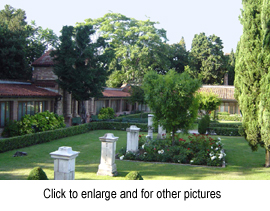
Semele "fixed her residence in a large palace [Palazzo
Contarini dal Zaffo] at the
northern extremity of Venice near the church of Our Lady of
the Garden [Madonna dell'Orto]. The view from the balcony of
the first floor, or Piano Nobile, of this palace was a thing
of enchantment. Below was a fertile garden rich with gay
flowers and intersected by straight alleys sheltered from the
rays of the sun by vines trained on trellis-work. Fig, almond,
peach, and pomegranate trees were studded here and there,
whilst some funereal cypresses toned down the laughing scene
around. To the garden succeeded an extensive grass plot,
having in the midst a large, empty basin of stone, presided
over by some colossal water-deity, attitudinizing in all the
mannerism of seventeenth-century art. This lawn terminated in
a balustrade slightly raised above the level of the lagune,
the waters of which caressed its base with their ripplings.
About a mile away in front, couched upon the mirror-like
sea, lay the island of Murano, rich with fair gardens, and
displaying its two massive church towers, one uncrowned with
cupola. To the right of Murano, and about half a mile apart
from it, gleamed in the clear atmosphere the church of San
Michele and the walls of its adjoining cemetery; ... ... Three hundred years before, great and ingenious minds
such as Titian, Sansovino, Navagero, Pietro Aretino, and
Sanmicheli were wooed to recreate in this favoured spot; and
in a spacious mansion near, since called Il Casino degli
Spiriti, probably germinated those flashes of genius and
triumphs of art which have illustrated the Italian name
throughout all lands." (Semele, p.37ff). Click on the
Venice Map link above.
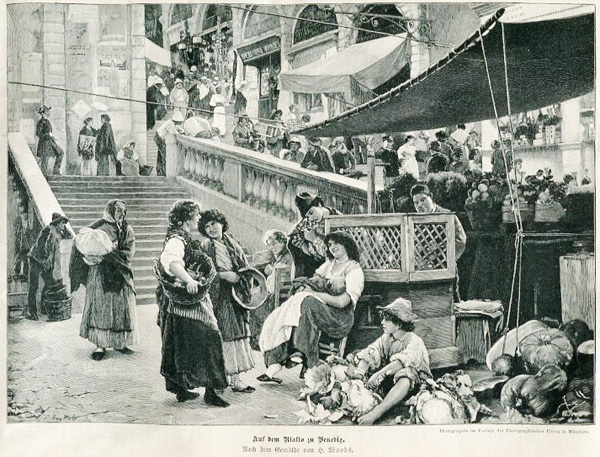
On the Rialto in Venice
After the painting by H. Woods
Published by Die Photographische Union in Munich, late
19th century
And soon Semele "arrived at the Ponte di Rialto, the
majestic proportions of which are destroyed by the
twenty-four shops which cloud and encumber the superjacent
arcades. (Palladio, Michel Angelo Buonarotti. Sansovino,
Scamozzi, and Fra Giocondo sent in models and plans for
this bridge. Those of Antonio dal Ponte were chosen, not
because they were the best, but because they were the
cheapest.) … … … And afterwards she descended the Bridge
of the Rialto, and at the bottom, looking behind her,
observed the people ascending and descending the stately
triple staircase, putting her in mind of a dream dreamt at
Bethel in times long past, save that the angelic natures
were wanting." (Semele,
p. 43ff)
The poor
"In the fourteenth and fifteenth centuries the population of
Venice was nearly three hundred thousand, and the poor were
prosperous, because fully occupied either as servants of the
great families, or as employed in the vast commerce which
flowed into this mart of nations. Besides this, their
physical welfare was carefully promoted by the powerful
Proveditori del Comune created for that purpose. These
officers arranged that the food of the working population
should be of the best and cheapest, and above all, they
restrained by severe laws severely carried out, the vendors
of necessaries from imposing on the poor. But now, Semele
found that the population was reduced to less than a hundred
thousand souls, and that the lower classes were no longer
prosperous, but miserable; for no rich houses fed and lodged
a crowd of gondoliers and servants, nor did the Port and
Arsenal give work and wages, as of old, to hungry
multitudes: nor were there any Proveditori to protect the
people from the over-charges and trickery of the bread,
meat, and wine sellers; whilst the innumerable charitable
and mutual aid societies once flourishing, had disappeared.
Consequently, thousands upon thousands were dependent for
their wretched existence on extraneous aid. And yet they
were good-tempered, courteous, intelligent, and even
disinterested, at least those who had not been brought in
contact with foreigners." (Semele, p. 47f)
Scala Contarini del
Bovolo
"During one of her walks, Semele discovered in the most
labyrinthine of labyrinths, in the Calle e Corte del Maltese
detta del Risi, leading out of the Calle della Vida, which
leads out of the Calle delle Locande, which must be approached
from the Rio Terrà di S. Paternian, close to the Campo of that
name, a circular staircase of exquisite geometrical
proportions, twenty-two feet in diameter, seventy in height,
and surmounted by a cupola which protects the whole from the
weather. This capo d'opera entirely constructed of Istrian
stone, is the production of an unknown architect of the
fifteenth century; and was probably constructed as a splendid
caprice, to act as an outer staircase to a palace more ancient
than the one it now adjoins. The whole structure breathes of
solidity and quaint grace, and fully merits its title of La
Scala Formosa." (Semele, p. 49) |
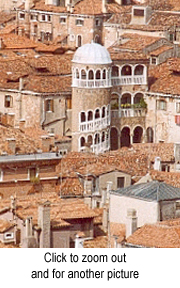 |
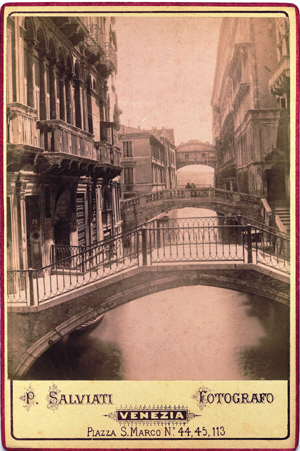 |
The Bridge of Sighs
Rio di Palazzo towards the
lagoon with Ponte dei Sospiri, c. 1880
The view of Ponte della Paglia
is obstructed by Ponte della
Canonica |
"And then she walked to and fro on the Piazzetta, between
the Giardinetto, or Royal Garden, and the Ponte della Paglia,
close over which loomed in the darkness the Ponte de' Sospiri,
built in 1591, after the plans of Antonio da Ponte the
architect of the Rialto Bridge. This closed bridge she was
informed, was divided longitudinally by a partition wall, the
passage to the south leading from the department of the
Avvogadori del Comun to the prison; that to the north,
connecting the prison with the Tribunal of the Ten. For in
Venice all was suspicious precaution and secrecy and
accordingly it would not have been meet that the prisoners of
the Council of the Ten should have been mingled in their
gloomy transit with those of the Avvogadori." (Semele,
p. 56)
| The
Arsenal
"Some days afterwards, Semele went early to the
Arsenal, ... ... In this vast group of buildings,
founded in 1104, and gradually increased to their
present extent, not many objects were found to interest
the feminine sensibilities of Semele. Four animals,
which her guide called lions, and eight others which he
named Pagan Deities, these monstrous specimens of
depraved renaissance art, and those monstrous
specimens of expiring Grecian art, sentinelled the
entrance to the ‘Arsenal of the Venetians’. The largest
of the lions, however, attracted her momentary interest
by the strange characters, probably of despairing
illegibility, traced upon his body. Whether they were
Pelasgic, or Greek, cotemporary with the battle of
Marathon, or Runic, or old Saxon chiselled for amusement
in the tenth century by the Varangian Guard of the
Emperors of Constantinople, no one could tell her.
Certain it was that they all came either from the
Piræus, or the road leading thence to ‘Town’, τό ’Άστυ, or from
somewhere else in Attica, for they were brought from
Athens in 1687 by Francesco Morosini during his
occupation of Achaia." Semele, p. 65ff) |
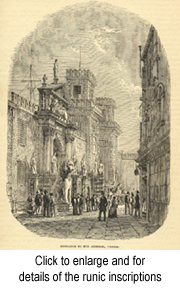 |
| The Island of San
Lazzaro
"From the Public Gardens Semele's gondola with its
four stalwart rowers swiftly flew over the still surface
of the lagune towards the island of San Lazzaro, once,
in 1182, a refuge for lepers; now the abode of Armenian
monks of the order of S. Benedict. And she was
courteously conducted over the domains of this
intelligent and gentle-mannered brotherhood, and shown
their church, and library of 14,000 volumes and 1,400
Armenian manuscripts, and their admirable
printing-press. There she saw some monks of extreme old
age, with very white beards; and all received her
cheerfully and kindly." (Semele, p. 71) |
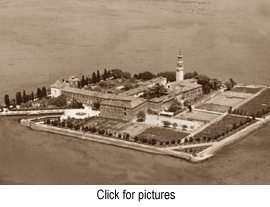
|
| The Lido
Semele "pursued her way to the Lido, and wandered
through waste places, rendered still sadder by
monumental memorials of Protestant and Israelite. But
over all this desolate scene, the lark, blithe spirit of
the islands of the lagunes, sang sweetly, as it had been
the soul of one of the entombed, guarding its mortal
remains. And she deciphered inscriptions on the
tombstones of British envoys and consuls ..."
(Semele, p. 71)
|
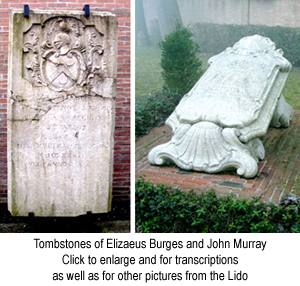 |
| From the
Lido
"The night damps were falling, the moon was hastening
towards her western goal ... ." So Semele "left the
Lido, and bent her course towards home. And on her way
she heard voices in a distant boat singing one of those
exquisite barcaroles, so full of soft plaintive melody,
which are peculiar to Venice. It was ‘La Barcheta ze a
la riva’, and so perfect was the harmony, and gracefully
simple the melody of this canzonetta, that the silvery
notes fell like a musical dew upon the surrounding
waters and lulled with their liquid influence the hearts
of the hearers into a half-waking trance, so saturating
their souls with soft music, that the internal echo
ceased not long after the singers were out of of
hearing." (Semele, p. 80f) |
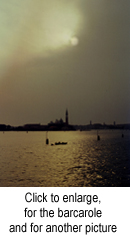 |
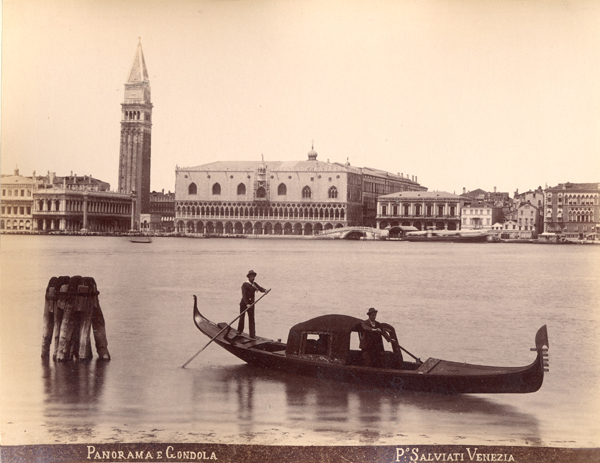
View from San
Giorgio across the Bacino di San Marco
Photograph by Paolo Salviati, c. 1880
"… one bright morning, Semele ordered her gondoliers to
conduct her into the mid-channel between the Church of S.
Giorgio and the Piazzetta. From thence the marvellous view
of the south side of Venice glowed before her. There was the
busy Riva degli Schiavoni laid out in all its sunny
splendour, until it merged into the massive verdure of the
Public Garden; the dark prison; the darker Bridge of Sighs;
the Ducal Palace, marvellous union of massive solidity with
graceful airy lightness, fair type of the junction of soul
and body; the southern portion of S. Mark's, inexplicably
rich in oriental marbles; the quaint tower of the Clock, the
two Columns, the Library, the Mint, the Imperial Palace and
Gardens, the lordly entrance of the Grand Canal, sentinelled
by the majestic church of the Salute; whilst on her left
sparkled the waters of the Canal of the Giudecca, with its
forest of masts. Over all, the radiant angel hovering on the
apex of the pyramidal termination of the gigantic Campanile
of S. Mark, seemed to give his benediction." (Semele,
p. 93)
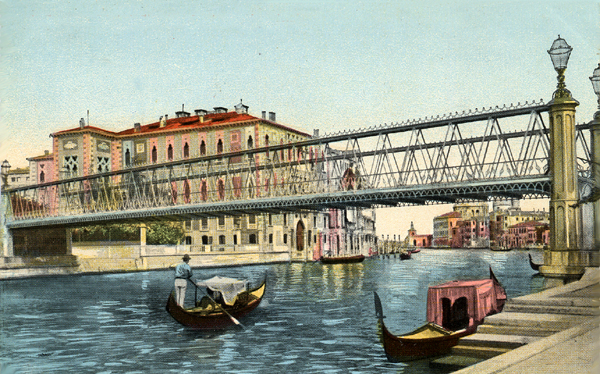
The Accademia bridge, built in 1854 by
the Austrians (demolished in the early 1930s)
Card
postmarked 1911, view towards la Dogana
Semele slowly glided over the limpid waters of the Grand
Canal from Punta della Dogana. "Then she rowed by the spot
soon to be desecrated by the most hideous of bridges
constructed by an English engineer, with a sense of beauty as
hard as the iron he employed in his work." (Semele, p.
95)
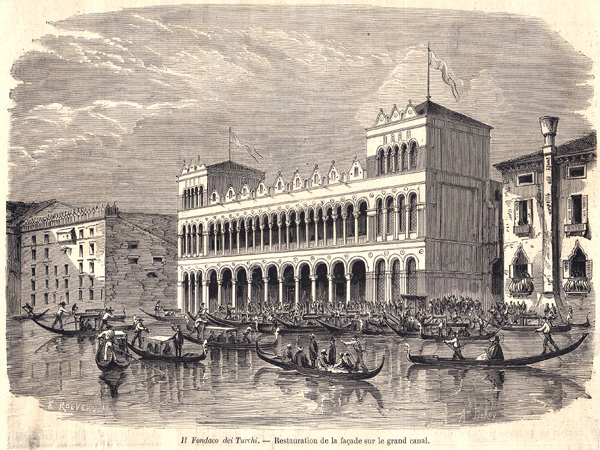
Il Fondaco dei
Turchi,
Restauration of the façade on the Grand Canal
Wood engraving by E. Roevens and A. Deroy, published in Le
Monde Illustré, 1869
"And a little
farther on, at the left hand, the long double ranges or
tiers of elegant Byzantine arches belonging to the Fondaco
de’ Turchi, work of the eleventh century, rose like a
pleasant dream. Most beauteous and rare in its semi ruin
this Oriental structure appeared to the eyes of Semele,
although the costly marbles which once incased it had long
since been torn away. And she reflected that this costly
edifice, work worthy of advanced civilization, stood in all
its unmutilated exquisite proportions at that remote epoch
when in England the Saxon Ethelred was treacherously
slaughtering Danish residents; when Sweyn, the fierce King
of Denmark, was seizing the English throne, amid the wailing
and execrations of massacred Saxons; and when Scotland
trembled under the usurping rule of the sanguinary Macbeth;
and that even then the tides of the Lagunes bathed the walls
of a city which could calculate its existence by centuries.
She cared not to hear that it once belonged to the Pesaro
family, and was by them ceded to the Government in 1380, who
presented it to the Duke of Ferrara; that it went into the
possession of Michele Priuli, bishop of Vicenza, and
afterwards was appropriated as the abode of the Turkish
merchants visiting Venice; but she did care to hear that the
Duke Alphonso of Este was once lodged here, and brought with
him his friend Torquato Tasso, that translucent fount of
limpid verse." (Semele, p. 100f)
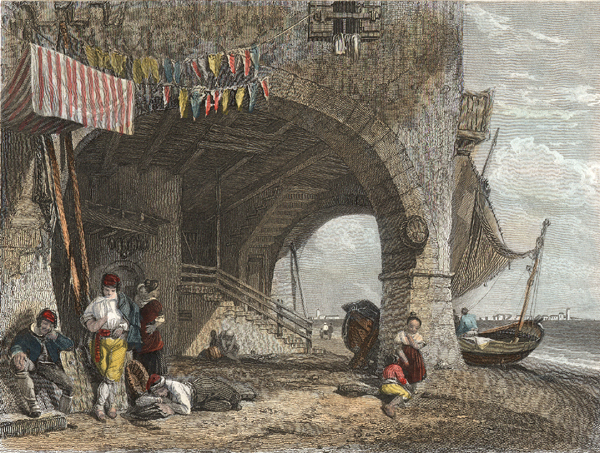
Mazzorbo
Steel engraving by C. Heath after a picture by C. Stanfield,
Longman & Co., London, c. 1840
From Burano
"passing over a long and narrow wooden bridge, she arrived
at Mazzorbo, the ancient Majurbium, formerly an island
faubourg of Altinum. This once populous island, anciently
the resort of Venetians during the summer season, had in old
times contained five parishes, numerous monasteries, and ten
churches. Now it was almost deserted, numbering but a few
inhabitants, who by their labour developed the indescribable
fertility of its gardens and orchards. And when Semele
recounted to her companions the melancholy feeling that
pervaded her as she trod on this desolate ground, formerly a
centre of civilization, she was reminded that these Lagunes
once possessed at least thirty islands, centres of religious
or secular interest, which are now either mournful swamps
inhabited by wildfowl, or entirely covered by the
treacherous waves, showing at low tide fragmentary ruins of
early civilization, or mediæval piety. They told her how
Costanziaca was once rich in many highly decorated churches,
now sunk beneath the surrounding hungry swamps; and how S.
Catoldo, anciently the seat of the Episcopal Seminary of
Torcello, was now but a slimy ridge, scarce rising above the
level of the waters, called by the vulgar Monte dell'Oro,
because, so they say, the golden car of the grim Attila, and
his other treasures, were buried there. So pondering over
these ruins of time, and reflecting how not only the
heavenly bodies, but indeed all earthly things seem to roll
unceasingly, never tranquil, round an immovable centre,
ending where they set out,
…" (Semele, p. 108f)
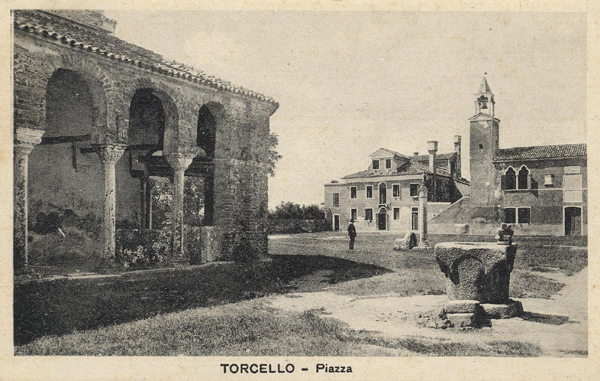
Torcello, the Piazza
Small size
postcard, c. 1910
"... Semele landed on the grass-covered Piazza of the once
superb Torcello. Here indeed she found proof upon proof of
time's vicissitudes. Could this unpeopled waste, approached by
a stagnant canal hardly restrained within its crumbling banks;
these melancholy fever-stricken gardens without cultivators;
this group of churches without worshippers, have ever been
populous, rich, and magnificent, radiant with marble palaces,
the new Altinum, rival of the old? ... ... Yes! This mockery
of a Piazza, glaring forth its poverty and neglect, was once
the centre of a rich and flourishing city, existing from a
remote period, as the old Venetian, Lombard, Hunnish, Roman,
and Grecian coins, frequently found beneath the soil, attest.
... ... But, alas! owing to the changed course of the waters
of the river Sile, fever was produced in this once favoured
spot; and then little by little the inhabitants decreased; so
in time it ceased to be a Bishop's see, the monasteries were
dissolved or transferred elsewhere, and thus by easy
gradations it descended to its lamentable state of present
perdition – its handful of cottages, its fifty or sixty
denizens. And there in the Piazza, in front of a barn and
granary, once a loggetta, from whence were proclaimed the laws
of the Republic and the Municipality, probably the remains of
the palace of the Podestà, Semele saw a rude stone chair,
popularly called "the Chair of Attila", whence the early
tribunes used to minister justice. She paused before the two
churches, the Duomo and Santa Fosca, each of surpassing
interest in its way, and carrying the observer back to the
remotest ages of Christian architecture." (Semele,
109ff)
Chiesa di San Pietro di Castello
"On the left hand, as one enters this church, there is to
be seen a very curious old tombstone, covering a vault, which,
as we learn from the inscription, belonged to the gondolier
fraternity at that ferry over the Grand Canal which is called
the Traghetto di San Barnaba. The inscription (in old
Venetian) runs thus:—
‘In tempo de Zorzi da Cataro
Gastaldo del
Tragetto
De San Barnaba
Et Nicolo de Zorzi
Et Migiel
de Bernardo
E. Compagni L. Anno
MDIII.’
Then follows a rude representation of a boat, something
like this:—
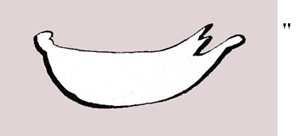
This is the church "of S. Pietro di Castello, containing,
as legends tell, the marble chair in which S. Peter sat at
Antioch". (Semele, p. 121f & note 5)
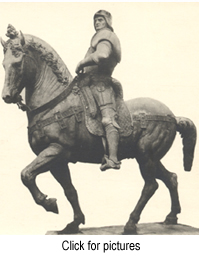
The Colleoni monument
"In the open space of ground adorned by the façades
of the Gothic church of SS. Giovanni e Paolo, and the
Scuola di San Marco, long changed into a Civil Hospital,
stands the equestrian statue of Bartolomeo Colleoni,
Commander of the Venetian land forces in the fifteenth
century, and the first artillery captain of his age.
This military chief, a Bergamasque by birth, left as a
legacy to the Republic, not only a hundred thousand gold
ducats, and the third part of ten thousand ducats due to
him from the Duke of Ferrara, but also all his arrears
of pay, with a request attached to his testament, that
an equestrian statue in bronze should be raised to his
honour in the Piazza di San Marco. The Senate accepted
the legacy, but departed from the wish of the donor by
erecting the memorial in the Campo de SS. Giovanni e
Paolo. There it has stood from the year 1495 with the
following inscription: 'Bartholomeo Coleono Bergamensi
ob militare imperium optime gestum. S. C.' ... ... ...
There was the successful soldier, in hardy daring
attitude sitting on his war-steed, more in the guise of
command than of good horsemanship, with his feet
stretched out before him almost scorning the assistance
of the stirrup. Under him, full of life and strength and
energy, and, luckily for the rider, thoroughly trained,
paced in quick walk the noble well-formed steed, so
life-like, that the pedestal seemed too short for the
step that he was certainly about to make."
(Semele, p. 128ff) |
Winter
"One bright
morning Semele walked on the terrace washed at its base by
the laughing daughters of the Adriatic. On her left the
terraced Alps reared themselves into the ether, commencing
with the fertile verdure-covered declivites descending into
the plain close to Conegliano, and ending with inaccessible
spirelike Tyrolean dolomite rocks. The sharp air of the more
early hours of the day at that advanced season had yielded
to the Italian sunshine; the night-mists had passed away,
and a most clear atmosphere rendered all distant objects
visible with a startling distinctness seemingly unreal to an
inhabitant of cloudy climes. And the leaves of the trees in
the many gardens of Murano were changing colour in
anticipation of the approach of winter with all its
severity*;" (Semele, p. 131ff)
"
* Let no one think that Venetian winters are devoid of
cold. What with the occasional Bora (Boreas), blowing from
the north-east over the snow-covered Alps, its girdle of
water, and its total absence of those endless appliances
which in northern regions regard animal comfort, Venice,
during the greater part of the months of January and
February, is practically one of the coldest places in Europe
to reside in. In January, 1858, the author saw the whole
Lagune frozen thickly over between Venice and Mestre, the
thermometer falling to 12° below zero (Réaumur) [ -15° C].
In other winters, the small canals in Venice are frequently
frozen over. Whilst these frosts last, the nights feel
milder than the days, during which, in spite of a good stove
in the sitting-rooms, the pen will fall from the numbed
fingers of the writer, shivering under a freezing
temperature. Perhaps the following notes of extremely cold
seasons in Venice will not be uninteresting to the reader.
[Here follow comments on the severe winters of the years
568, 852, 1118, 1413, 1419, and 1431 when] a frost commenced
the 6th of January, and lasted until the l2th of February,
during which interval a bride came from Mestre in a carriage
over the ice, bringing her dowry with her, [as well as 1486,
1514, 1548, 1549, 1598, 1601, 1608, 1684, 1709, 1716, 1740,
1758, and 1788-1789 when] the Lagunes were frozen over from
the 28th of December to the 24th of January, and a road was
kept clear to Mestre, by which passed all the heavy and
light traffic, and public-houses and amusements were rife
upon the ice. On the night of the commencement of this frost
many people died of cold in the streets, the houses, and the
cafes."
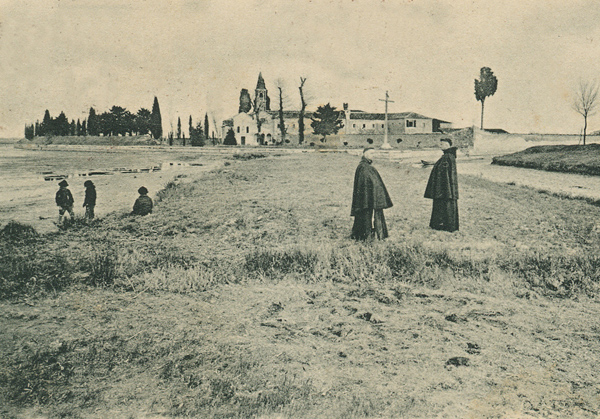
Isola San Francesco del Deserto,
c. 1900
One night at "half-past nine Semele ordered her gondola
with four rowers to be prepared to take her to the island of
S. Francesco nel Deserto." (Semele, p. 153) "... she found her
way into the half-ruined, desecrated church, and kneeling
close to the narrow cell where S. Francis used to sleep,
poured forth thanksgivings for having attained the object of
her fondest hopes. Thence she passed into the open space,
where was a rude hut, in which the venerable saint used to
pray, now almost filled up by the lower part of the trunk of a
large cypress tree. Then she, led by some mysterious impulse,
moved joyfully and fearlessly forward into a large piece of
ground at the back of the convent, looking towards the swampy
shores of Erasmo, on the other side of which chafed the
restless Adriatic. In the middle of this space grew five tall
cypresses, so grouped together, that the largest stood in the
centre surrounded by the four others. Against this tree she
leaned, awaiting with fond confidence the arrival of the
object of her strange and passionate love
– her sense of the
Beautiful accurately shaped forth in intensest concentration.
The rain and wind had ceased, but the black cloud remained,
and every now and then the vivid lightning laid open its lurid
recesses, leaving every thing blacker than before. And then
Semele, with hands erect, as one earnestly praying, said, 'O
glorious Spirit, that fillest the universe with thy presence,
behold me here, unceasing seeker of thee in visible form! Be
present now according to thine infallible promise, and afford
me, at least, one glance of thy divine attributes, thus
satisfying the life-long cravings of a heart and brain, which
would comprehend in one vivid concentration all the infinite
beauty of the material universe.'" (Semele, p.
159f)
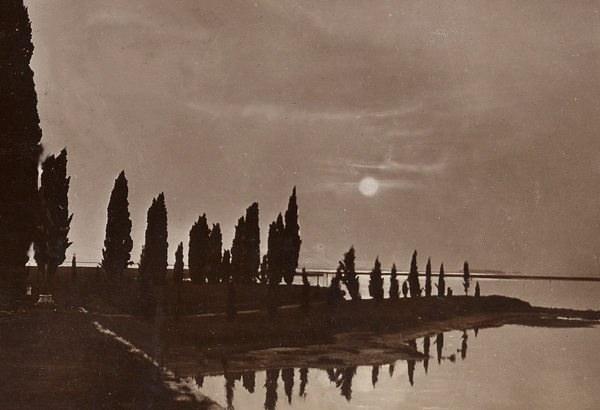
Further reading: P. Bernardino Barban,
L'Isoletta di "S.
Francesco del Deserto" nelle Lagune di Venezia,
Vicenza 1927.
On the inside of the front cover
of the Semele copy depicted above, there is a
bookplate:
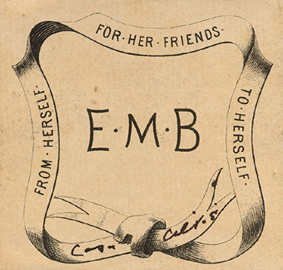
E · M · B
FROM · HERSELF ·
FOR · HER · FRIENDS ·
TO · HERSELF ·
Casa Alvisi
[Venice]
This would be Edith Millicent
Bronson. She was born in Newport, RI, USA, in 1861. In 1895
she married Count Cosimo Rucellai, Florence.
